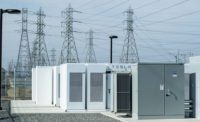Construction would involve extensive transmission lines, a warehouse and administration buildings and large 250-ft wide by 450-ft long by 70-ft high buildings to house the voltage source converters, which will be manufactured in England by Alstom Grid under a $200-million contract.
Roadways will need to be improved to access the remote site to allow for the hundreds of truckloads carrying as much as 600,000 lbs each of equipment and materials.
The real boon, though, won't come directly from Tres Amigas' construction jobs, but from the expected influx of transmission lines and renewable energy producers to the area, Hendrick says. "A shortage [of] transmission capacity [is] keeping us from developing our excellent wind and solar possibilities," he says. "We are hoping that as soon as activity begins at Tres Amigas, transmission companies will be out here immediately trying to get a leg up in stringing lines."
As New Mexico nears capacity on its transmission lines, it faces pressure to compete with neighboring states for renewable development. Texas is currently completing its $7-billion Competitive Renewable Energy Zones (CREZ) transmission line project, which facilitates renewable energy development by interconnecting wind farms in the Panhandle and west Texas to the large metropolitan areas to Dallas and other large metro areas. Ironically, it was CREZ that makes Tres Amigas feasible by bringing ERCOT connections within close proximity to the other two power grids near the Panhandle.
The project will include a 9-MW battery system on site. “We can use it to firm up the renewable generation to take out some of the flucuations and variations so it looks more like fossil fuel generation,” Stidham says. Tres Amigas will also offer spinning reserves and supplemental non-spinning reserves that could transmit increased output in response to major generator or transmission outages.
Early on, Tres Amigas announced plans to use underground superconducting DC cables to transmit power in the project. Stidham now says they are not planning to introduce the technology until the third phase. While superconductivity cables are vastly more efficient than traditional copper lines, the technology has only been used in several test cases in the U.S., making its adoption in the risk-adverse power industry very slow, Eckroad says. The adoption of superconductivity has also been hindered by the Dept. of Energy’s freezing of funding for more tests under the current administration. “I am very hopeful that Tres Amigas will be able to go ahead because we do need to have a continuing presence [in superconductivity use],” he adds.



Post a comment to this article
Report Abusive Comment